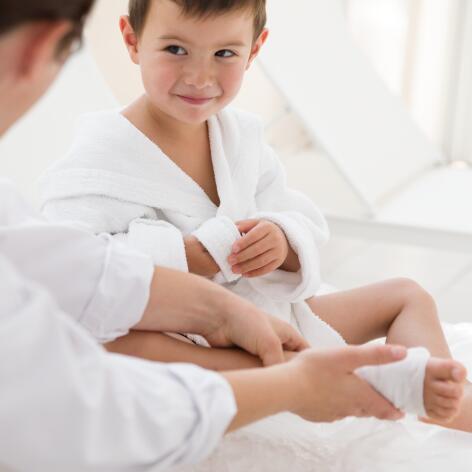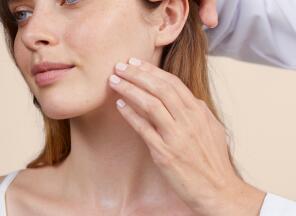Psoriasis, eczema for children: moisturising rules
- Living with eczema and psoriasis
- Living with eczema and psoriasis: Children
- Psoriasis and eczema for children - rules for moisturising
- Psoriasis and eczema in adults: suitable hygiene
- Adults - Care and anti-itching tips
- Children - Care and anti-itching tips
- Psoriasis and eczema in children: suitable hygiene
- Living with eczema and psoriasis: Adult
- Psoriasis and adult eczema - rules for moisturising
Psoriasis, eczema for children: moisturising rules
Eczema and psoriasis: how to moisturise your child's skin If your child has eczema or psoriasis, moisturising their skin requires your attention every day. With patience (and a few tips), you can help your child to use the treatment every day in complete peace of mind.
Tips for soothing your child !
Eczema and psoriasis have an impact on your little one's quality of life. When the skin is dried out, it causes tightness and itching. This is particularly true for atopic eczema. The result is insomnia and stress for your child... But also for you. By mastering the techniques for moisturising your child's skin, you’ll have everything on your side to soothe and support your child. Skin that's well-moisturised protects against the onset of flare-ups and sometimes unbearable itching. This reduces the risk of secondary infection. The inflammation subsides and the urge to scratch fades.

FRIENDLY, EXPERT ADVICE
Emollient balms should be used, especially if they contain an anti-itching ingredient that will calm the skin
Joëlle Nonni
Head of Skin Health Education Workshops - The Avène Centre
Suggestions to protect skin hydration
To soothe your little one's skin, there are plenty of gentle hygiene products and emollient care products available.
- To combat skin that’s dried out, emollients moisturise your child's skin . As well as soothing, emollients greatly reduce the risk of infection and secondary infection.
- A moment of softness for your little one. When the emollient is applied, the massage relaxes your child, giving them a sense of calm and serenity.

Playing YouTube videos requires the use of cookies in order to offer you targeted advertising based on your browsing For more information, please visit YouTube's « cookie » policy.
You have rejected Youtube's cookies and therefore you cannot view the video.
You can change your choices by clicking on « Cookie Settings » and accept Youtube's cookies to enable the video.
You can change this setting and withdraw your consent at any time.
Eczema and psoriasis: calm, continuous hydration
Your child's eczema and psoriasis can be alleviated by daily moisturising
When it comes to tackling eczema and psoriasis , nothing beats prevention.
Between outbreaks, keep applying the emollient. Even if your child's skin seems less dry, don’t stop moisturising to space out inflammatory flare-ups.
To combine hydration with peace of mind,
it can be better to say "Come on, I'll give you a massage", rather than "Come and put on your cream". Turn the moment of applying the emollient into a game or a moment of softness: a good little trick to engage your child.
FRIENDLY, EXPERT ADVICE
Does your child not like putting on their cream? How can you get your child to accept using emollient?
From the constraint of applying the cream...
- To a moment of pleasure, by applying the emollient with a massage. This becomes a precious moment of sharing between parent and child, allowing for a relaxing, calm moment.
- To a playful game, having fun with Coco and Léo. Your child applies the emollient by making white dots on the face and body to dress up as a ladybird or leopard. Then they can spread the emollient gently on the Coco the Ladybird’s delicate wings or Leo the Leopard’s soft coat. For even more fun, why not suggest they apply their emollient while listening to our Coco and Leo nursery rhyme.
The right way to moisturise your child gently
Applying emollients is easier after washing:
- Avoid rubbing the skin so as not to irritate it.
- On the face, apply the emollient gently with the fingertips.
- On the body, spread the product in the hands before applying it with large circular movements with the entire surface of the hand
- After applying, the skin should feel soft and silky, not greasy or sticky
Playing YouTube videos requires the use of cookies in order to offer you targeted advertising based on your browsing For more information, please visit YouTube's « cookie » policy.
You have rejected Youtube's cookies and therefore you cannot view the video.
You can change your choices by clicking on « Cookie Settings » and accept Youtube's cookies to enable the video.
You can change this setting and withdraw your consent at any time.
OUR SOLUTIONS FOR MOISTURISING YOUR CHILD'S SKIN
Eau Thermale Avène skin care products designed to moisturize your child's skin:
NEWSLETTER
We're always here for your skin!
All our advice on how to take care of your skin day to day.

Which skin care routine should you adopt?
Identify what it really needs with the help of our experts and discover the most suitable skin care routine for you.
